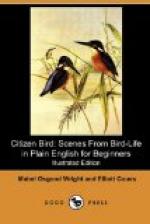“Yes, they are very uncomfortable indeed, and often starve to death; but you must wait to hear about that until we come to the Cowbird himself.”
“What family does he train with?” asked Nat.
“With the Blackbirds and Orioles,” said the Doctor.
Then the male Yellow Warbler flew out along a branch above their heads, gave his lisping song, that sounded like “sweet, sweet, sweet, sweeter,” seized an insect, and went across the garden toward his nest.
“I’m going to watch that nest,” said Rap, “and if a Cowbird lays in it any more I’ll take the wicked old egg away.”
“Sweet, sweet, sweet,” called the Warbler from the bushes.
“Maybe he understood you,” said Dodo. “I’d believe most anything about birds.”
The Yellow Warbler
(Or SUMMER YELLOWBIRD)
Length about five inches.
Upper parts rich olive-yellow, brightest on the rump and crown, but dark brown on wings and tail, with the inside half of each tail-feather yellow, and some yellow edgings on the wing-feathers.
Under parts bright yellow, in the male streaked with rich brownish-red.
A Summer Citizen of the greater part of North America, nesting in orchards and bushes, and going to the tropics in winter.
Belongs to the guilds of Tree Trappers and Sky Sweepers.
THE YELLOW-RUMPED WARBLER
(Or MYRTLEBIRD)
“This Warbler does not sing much of a song, even in nesting-time; but you will know him on the wing by the bright yellow spot on the rump, and if he perches near by perhaps you will also see the crown of gold on the head and a spot of yellow on each side of the breast. They say there was once a great king named Midas, whose touch turned everything to gold, he was such an avaricious old miser. If that be true he must have put his finger on the Myrtlebird in four different places. Unlike most of his family the Yellow-rump is fond of seeds and berries; and so he is able to live further north in winter than any of his brothers. Unless you are spending the summer near the Canadian border you will not see him in his own home. But when they are on their journeys in spring and autumn you will meet them almost everywhere, travelling in sociable flocks.”
[Illustration: Yellow-Rumped Warbler.]
“It must be that dark-backed bird with a yellow spot on his tail, that gobbles all the bayberries—and eats the poison-ivy berries too,” said Rap. “Yes, I see that you know him; ’that dark-backed bird with a yellow spot on his tail’ is not a bad description of the Myrtle Warbler,” said the Doctor; “at least, as you generally see it, in autumn or winter, when that particular spot is the only one of the four which shows off well.”
“But why is he called Myrtle Warbler?” asked Nat. “Does he build his nest in myrtle? I thought myrtle was that shiny-leaved plant down on the ground, that doesn’t have berries.”




